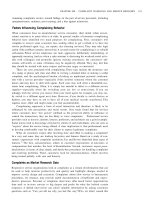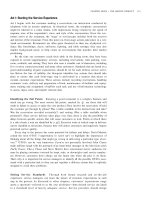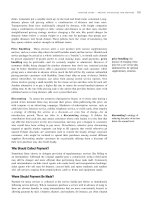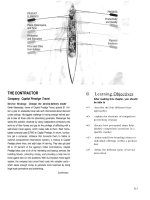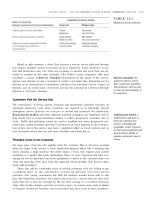The Sustainability Of The National Health Insurance Scheme In The Kintampo Municipality: The Role Of Service Providers And Field Agents
Bạn đang xem bản rút gọn của tài liệu. Xem và tải ngay bản đầy đủ của tài liệu tại đây (1.06 MB, 93 trang )
THE SUSTAINABILITY OF THE NATIONAL HEALTH INSURANCE SCHEME
IN THE KINTAMPO MUNICIPALITY: THE ROLE OF SERVICE PROVIDERS
AND FIELD AGENTS
by
SALIFU NUHU
(PG3090209)
A Thesis submitted to the Institute of Distance Learning, Kwame
Nkrumah University of Science and Technology in partial fulfillment of
the requirements for the degree of
COMMONWEALTH EXECUTIVE MASTERS OF BUSINESS
ADMINISTRATION
April, 2012
CERTIFICATION
I hereby declare that this submission is my own work towards the CEMBA degree and
that, to the best of my knowledge, it contains no material previously published by another
person nor material which has been accepted for the award of any other degree of the
University, except where due acknowledgement has been made in the text.
Salifu Nuhu (20103969)
Student Name & ID
……………………
Signature
………………....
Date
……………………
…………………..
Certified by:
Cassius Amoako
Supervisor’s Name
Prof. I. K. Dontwi
Dean, IDL
Signature
…………………….
Signature
ii
Date
……………………
Date
DEDICATION
I dedicate the entire work to Almighty Allah for taking care of my life throughout my
education, and to my dear mother, Madam Fatima Abubakari for her advice and support
towards my success in education, and finally to my children: Buhari, Khadijah, Abdalla
and Aminah.
iii
ACKNOWLEGEMENT
My appreciation goes to the Almighty Allah for His wisdom, Knowledge, mercies and
direction in the writing of this thesis.
I would also like to acknowledge my supervisor Mr. Cassius Amoako of KNUST –
Institute of Distance Learning for his fatherly and excellent manner in which he
approached and handled the supervision of the thesis.
Again, I acknowledge and appreciate other authors whose published materials have been
refereed to and cited in this thesis.
I would like to thank Kwaku Asare for his help in editing of this work.
I am profoundly grateful to the Kintampo Municipal Director of Health Services and
staff, Mr. Amoako Adoesom (Scheme Manager of Kintampo Municipal Mutual Health
Insurance Scheme) and his staff and my entire staff for their cooperation during the
collection of data.
Additionally, I acknowledge the various facilitators of the Commonwealth Executive
Master in Business Administration, Institution of Distance Learning, KNUST.
Finally, my thanks go to friends and my family who have been of help in diverse ways to
bring this thesis to a successful end.
iv
ABSTRACT
This study provides an assessment of the role of service providers and field agents in the
sustainability of National Health Insurance Scheme taking Kintampo Municipality as the
case study. It provides an empirical platform for assessing how the health service
providers and field agents are helping in the sustainability of the scheme. Kintampo
Municipality was chosen because it was among the first National Health Insurance
Schemes that were inaugurated by the then President John Agyekum Kuffour on 18th
March, 2004. Questionnaires, interview and focal group discussion were the data
collection instruments employed. The data were analyzed using tables, percentages,
graphs, charts and diagrams. The study revealed that the health service providers and
field agents play major roles in the sustainability of the National Health Insurance
Scheme in Ghana. However, the extent to which health service providers and field agents
achieve their roles in the municipality was limited by factors such as untimely release of
funds by government, political interferences, limited health facilities to meet the high
coverage of the scheme, lack of logistics for field agents, training and motivation. The
following recommendations were made from the findings: The government should
release funds early to the scheme, there should be intensive education of residents on the
health insurance concept, the health facilities should be expanded and more health
personnel should be trained to cater for the growing population in the municipality.
v
TABLE OF CONTENT
CERTIFICATION ............................................................................................................ ii
DEDICATION ................................................................................................................. iii
ACKNOWLEGEMENT ................................................................................................. iv
ABSTRACT ....................................................................................................................... v
TABLE OF CONTENT................................................................................................... vi
LIST OF TABLES ............................................................................................................ x
LIST OF FIGURES ......................................................................................................... xi
ABBREVIATIONS ......................................................................................................... xii
CHAPTER ONE INTRODUCTION ............................................................................ 1
1.1 Background to the Study ........................................................................................................ 1
1.1.2 The Concepts of Health Insurance in Ghana................................................................... 2
1.2 Problem Statement ................................................................................................................. 4
1.3. Objective ............................................................................................................................... 5
1.3 .1 General Objective .......................................................................................................... 6
1.3. 2 Specific Objectives ........................................................................................................ 6
1.4 Research Questions ................................................................................................................ 6
1.5 Overview of Research Methodology ..................................................................................... 7
1.6 Significance of the Study ....................................................................................................... 7
1.7 Scope and Limitations of the Study ....................................................................................... 8
1.8 Organization of the Study ...................................................................................................... 9
CHAPTER TWO
REVIEW OF LITERATURE ..................................................... 10
2.1 Overview of Health Insurance ............................................................................................. 10
2.2 Universal Financial Protection: Obstacles to Implementation of Insurance Schemes ......... 12
vi
2.3 Characteristics of Health Information System in Ghana...................................................... 14
2.4 Concept of Sustainability ..................................................................................................... 18
2.4.1 Affordability of Contributions ...................................................................................... 18
2.4.2 Unit of Enrolment ......................................................................................................... 20
2.4.3 Distance......................................................................................................................... 21
2.4.4 Timing of Collection of Contribution ........................................................................... 22
2.4.5 Quality of Health Care .................................................................................................. 23
2.4.6 Trust .............................................................................................................................. 24
2.5 Health Insurance Coverage .................................................................................................. 26
2.6 Problems in the Health Insurance Market ............................................................................ 27
2.7 Health Insurance in Kintampo Municipality........................................................................ 28
CHAPTER THREE
METHODOLOGY ................................................................... 30
3.0 Introduction .......................................................................................................................... 30
3.1. Study Design and Methods ................................................................................................. 30
3.2 Scope of the Study ............................................................................................................... 31
3.3 Study Population .................................................................................................................. 31
3.4 Sampling Method and Sampling Size .................................................................................. 32
3.5 Data Collection Techniques and Tools ................................................................................ 33
3.6 Pretesting of Study Instruments ........................................................................................... 33
3.7 Ethical Consideration ........................................................................................................... 33
3.8 Data Handling ...................................................................................................................... 33
3.9 Data Analysis Technique ..................................................................................................... 34
3.10 Validity and Reliability of the Research ............................................................................ 35
3.11 Profile of the Study Area ................................................................................................... 35
3.11.1 Geographical Location and Size ................................................................................. 35
vii
3.11.2 Population Growth and Spatial Distribution ............................................................... 38
3.11.3 Climate and Vegetation............................................................................................... 40
3.11.4 Relief and Drainage .................................................................................................... 41
3.11.5 Major Economic Activities ......................................................................................... 42
3.11.6 Transportation System ................................................................................................ 43
3.11.7 Telecommunication..................................................................................................... 43
3.11.8 Ethnicity and Religion ................................................................................................ 43
3.11.9 Health Services Delivery ............................................................................................ 44
3.11.10 Common Diseases in the District .............................................................................. 45
3.11.11 Issues of Public Health Importance .......................................................................... 47
CHAPTER FOUR DISCUSSIONS OF RESULTS ................................................... 49
4.0 Introduction .......................................................................................................................... 49
4.1 Socio-Demographic Characteristics of the Respondents ..................................................... 49
4.1.1 Age Distribution............................................................................................................ 49
4.1.2 Gender Composition ..................................................................................................... 50
4.1.3 Educational Background of the Respondents ............................................................... 51
4.1.4 Marital Status ................................................................................................................ 52
4.1.5 Religion ......................................................................................................................... 53
4.2 The Role of Service Providers in Ensuring Sustainability of the Scheme ........................... 53
4.3 The Role of Field Agents in Ensuring Sustainability of the Scheme ................................... 57
4.4 Challenges that can affect the Sustainability of NHIS ......................................................... 60
CHAPTER FIVE SUMMARY, CONCLUSION AND RECOMMENDATIONS . 62
5.1 Summary of the Study ......................................................................................................... 62
5.2 Conclusions (Findings) ........................................................................................................ 62
5.2.1 The Role of Service Providers in Ensuring the Sustainability of the Scheme .............. 63
viii
5.2.2 The Role of Field Agents in Ensuring the Sustainability of the Scheme ...................... 64
5.2.3 Challenges Identified: ................................................................................................... 65
5.3 Recommendations ................................................................................................................ 66
REFERENCES................................................................................................................ 70
APPENDIX ...................................................................................................................... 76
ix
LIST OF TABLES
Table 3.1: Study Population……………………………………………………………...31
Table 3.2 Sampling Size and Data Collection Techniques………………………………32
Table 3.3: Distribution of Population ............................................................................... 39
Table 3.4 Distribution of Health Facilities in the Kintampo Municipality ....................... 45
Table 4.1.1 Age of the Respondent ................................................................................... 50
Table 4.1.2 Gender Composition of Respondents ............................................................ 51
Table 4.1.3 Educational Background of Respondents ...................................................... 51
Table 4.1.4 Marital Status of the Respondents ................................................................. 52
Table 4.1.5 Religion of the Respondents .......................................................................... 53
Table 4.2 The Role of Service Providers .......................................................................... 54
Table 4.3: The Role of Field Agents ................................................................................. 58
x
LIST OF FIGURES
Figure 3.1 Ghana Map Showing Kintampo Municipality ................................................ 37
Figure 3.2: Kintampo Municipal Map .............................................................................. 38
Figure 3.3: Top Ten Causes of OPD Attendance in the District. ..................................... 46
Figure 3.4: Top Ten Causes of Hospital Admissions in the Municipality. ...................... 47
xi
ABBREVIATIONS
BAR
- Brong Ahafo Region
CDI
- Centre de deveppement integre
CHI
- Community-Base Health Insurance
CHPS
- Community-Based Health Planning Services
FGD
- Focus Group Discussion
GDRG
- Ghana Diagnostic Related Grouping
GHS
- Ghana Health Service
GK
- Gonosasthya Kendra
ILO
- International Labour Organisation
JHS
- Junior High School
KMHD
- Kintampo Municipal Health Directorate
KMMHIS
- Kintampo Municipal Mutual Health Insurance Scheme
LI
- Legislative Instrument
MHMT
- Municipal Health Management Teams
MOH
- Ministry of Health
MPCU
- Municipal Planning Coordinating Unit
NHI
- National Health Insurance
NHIA
- National Health Insurance Authority
NHIS
- National Health Insurance Scheme
ORT
- Oral Rehydration Therapy
PNDC
- Provisional National Defense Council
P&T
- Post and Telecommunication
xii
SEWA
- Self Employed Women’s Association
SHS
- Senior High School
WHO
- World Health Organisation
xiii
CHAPTER ONE
INTRODUCTION
Health insurance is a type of insurance that pays for medical expenses prior to health
service delivery. It is sometimes used more broadly to include insurance covering
disability or long-term nursing or custodial care needs. It may be provided through a
government-sponsored social insurance program, or from private insurance companies. It
may be purchased on a group basis (e.g., by a firm to cover its employees) or purchased
by individual consumers. In each case, the covered groups or individuals pay premiums
or taxes to help protect themselves from high or unexpected healthcare expenses. Similar
benefits of paying for medical expenses may also be provided through social welfare
programs funded by the government.
1.1 Background to the Study
Scarce economic resources, low or modest economic growth, constraints on the public sector
and low organizational capacity explain why the design of adequate health financing systems
in developing countries, especially the low income ones, remains cumbersome and the
subject of significant debate. In 1980s, a cost-recovery for health care via user fees was
established in many developing countries usually as a response to severe constraints on
government finance. However, most studies alert decision-makers to the negative effects of
user fees on the demand for care, especially that of the poorest households (WHO, 2003).
Alternative health financing systems exist, de-linking utilization from direct payment, and
thereby protecting the population, especially the most vulnerable groups, from having to
resort to various copayment mechanisms. Financing of health delivery is based either on
general tax revenues and/or social health insurance contributions. Mutual Health Insurance
1
Schemes have evolved rapidly as alternative financing institutions in the health sector in
recent years. Their objective generally is to provide an alternative to user fees through
community risk-pooling mechanisms, and to ensure access to health care of acceptable
quality to their members (Atim, 1998). A tax funded health system may not be easy to
develop, due to the lack of a robust tax base, a low institutional capacity to collect taxes and
weak tax compliance (WHO, 2003).
Social health insurance has traditionally started by insuring workers. A further nationally
organized expansion of social health insurance to the self-employed and non-formal sector is
especially demanding. Other financing methods which would circumvent these health care
difficulties are therefore explored, including the direct involvement of communities in health
financing (WHO, 2003).
1.1.2 The Concepts of Health Insurance in Ghana
Before the introduction of the National Health Insurance Scheme (NHIS), Ghana has
operated a cost-recovery health delivery system known as the ‘cash-and-carry’ system
since 1985. With this system patients were required to pay up-front for health services at
government clinics and hospitals. This, however, pushed health care far beyond the reach
of the ordinary Ghanaian for which many were not seeking health delivery services from
hospitals and clinics resulting in needless deaths. The challenge since 1981 has been how
to find the best combination of Government-Peoples-Partnership that would meet each
other part of the way and satisfy the needs and pockets of Ghanaians as well as the
Government’s finances in the healthcare sector.
2
‘Cash and Carry’ the system of healthcare financing introduced by the PNDC survived
until 2004 when the present health insurance system came into being. Even then a large
number of Ghanaians (about 30 percent) still subsist on cash and carry for their
healthcare requirements as they have not registered to join the NHIS. This is one of the
major challenges facing the Government and the Management of the National Health
Insurance Authority (NHIA, 2009).
Under ‘Cash and Carry’, patients were required to pay for drugs and some medical
consumables, as and when they visit hospital, while the state bore all other
costs including consultation, salaries and emoluments for doctors, nurses and other
healthcare workers in state hospitals. ‘Cash and Carry’ also provided for free medical
care for the aged above 70 years, children under five years and pregnant women for
their ante-natal care, all under an exemption program implemented with that system of
financing, thus, cash and carry.
Under ‘Cash and Carry’, people went to hospital only when they were very sick and had
money to pay for the stipulated health expenditures. The result of this is that most often
people went to hospital when they were really very sick and often at the terminal end of
their lives. It was pointed out that ‘cash and carry’ constrained citizens from assessing
healthcare except when they were in very dire situations (NHIA, 2009).
As part of the social interventions and health reforms provided by the government of
Ghana to improve and expand the health service delivery and infrastructures in the
country respectively, the government of Ghana introduced the National Health Insurance
Scheme (NHIS) in the Country in 2003. This was to enable any ordinary Ghanaian to
3
access quality health care in the country. President Kufuor at the lunch (18th March,
2004) of the scheme attributed an ‘unacceptable’ 80 per cent of ill-health and early deaths
in Ghana to infectious diseases, pregnancy and child-related problems and accidents. He
said in future, such ailments will be catered for under the Health Insurance Scheme.
Before the NHIS, there were pilot programs in the Dangme West District in the Greater
Accra Region and Nkoranza District of the Brong Ahafo Region as a means of laying a
firm foundation for what eventually became the National Health Insurance Scheme
(NHIA, 2009).
1.2 Problem Statement
Mutual Health Organizations have exhibited promise in their ability to attract members,
efficient finance care and to provide access to their members for their health care needs
(Crier, 1999). However, the Mutual Health Organizations remain relatively young and
work remains to be done to ensure their long-term sustainability and their potential to
leverage quality improvements in the health sector. Evidence from a study undertaken by
Kelly and Quijada (2001) in three countries indicates that Mutual Health Organizations
themselves consistently identify quality as a priority. A lot of research has to be carried
out to identify the weaknesses and strengths so as to make informed and proper
recommendations to the management and policy makers of the scheme.
Ghana has prioritized universal coverage of health care and has therefore put in place
policies and programmes to meet this goal. Even though success has been achieved in
different aspects of the health sector, health care delivery remains inadequate especially
for the poor people and other disadvantaged groups. The task confronting the health
4
sector remains difficult; life expectancy remains low (60 years), morbidity of preventable
diseases remains high; malaria, diarrhoea and other preventable diseases account for
about 40% of child mortality and maternal mortality is still high (WHO, 2003).
In recent times, most of the District Mutual Health Insurance Schemes in the country are
running into distress by their indebtedness to health care providers which compelled the
health care providers to deny services to card bearing members of the NHIS. Some of the
service providers have threatened to withdraw the services of health insurance clients if
the amount owed by the schemes is not paid (GHS, 2008). The concern therefore is
whether the National Health Insurance Scheme would be sustainable in future. There is
therefore the need to examine the concepts of the National Health Insurance Scheme to
ascertain the viability and its sustainability.
The health care providers are expected to provide quality health care to the NHIS card
bearers to ensure trust in the system. Again, the field agents popularly known as
collectors are also expected to play positive role to ensure the sustainability of the scheme
in the municipality notwithstanding the challenges they face in their daily activities. If the
functions of these groups are not properly checked then the future of the National Health
Insurance Scheme would be bricked. In the light of these developments, the research
hopes to look at the role of service providers and field agents in the sustainability of the
National Health Insurance Scheme in the Kintampo Municipality.
1.3. Objective
The objective is categorized into general and specific.
5
1.3 .1 General Objective
The aim of the research is to assess the role played by the health care (service) providers
and the field agents in ensuring the sustainability of the National Health Insurance
Scheme by studying the case of the Kintampo Municipality.
1.3. 2 Specific Objectives
The specific objectives are to:
1. Identify the role played by service providers in ensuring the sustainability of
NHIS in the Kintampo Municipality.
2. Evaluate the contributions of field agents in the sustainability of health
insurance in Kintampo Municipality.
3. Indentify the challenges faced by the service providers and field agents in the
implementation of health insurance scheme in the municipality
4. Make recommendations on policies governing the sustainability of NHIS.
1.4 Research Questions
The following research questions were addressed.
1.
What are the roles played by the service providers in ensuring the
sustainability of NHIS in the Municipality?
2.
What are the contributions of field agents to ensure the sustainability of NHIS
in the Municipality?
3.
What are the challenges faced by the service providers and field agents in the
implementation of health insurance scheme?
6
1.5 Overview of Research Methodology
The information used in this research was through both primary and secondary sources.
The primary data were gathered through questionnaires and extensive face-to-face
interviews with health insurance workers, health care providers and field agents of the
National Health Insurance Scheme in the Kintampo Municipality. The data were
analyzed using tables and charts. A multistage sampling technique was employed in
selecting the study municipality, health facilities and participants. The municipality was
clustered into 10 sub-districts based on the MHMT’s demarcation. These design and
methods were employed because the researcher wanted to have accurate and authentic
information for his work. Again, the researcher wanted a fair representation of the
respondents. The design and the methods enabled the researcher to finish his work on
schedule because right people were contacted for the information. The complete
enumeration done on all the heads of health institutions enabled the researcher obtained
relevant and first hand information for his work.
The secondary data were obtained from textbooks, articles, journals, magazines,
newspapers, handouts, annual reports and the internet.
1.6 Significance of the Study
The research will be of tremendous value to persons and institutions. It could serve as a
teaching material to trainers, teachers and instructors who impact knowledge and skills of
Health Insurance Schemes and Ghana Health Service. The findings would again benefit
Management of Health Insurance Schemes, Kintampo Municipal Health Management
Team, Ghana Health Service, National Health Insurance Authority, Government and
7
other stakeholders on effective strategies to adopt to achieve quality health care to sustain
the NHIS in the country.
In addition, prospective researchers and or students can use it as secondary data and part
of their literature review.
1.7 Scope and Limitations of the Study
The research was mainly based on the roles of service providers and field agents in the
sustainability of NHIS in the Kintampo Municipality. Among the limitations of the study
are the following.
First, getting the consent from study participants (thus, the field agents) was a hell of
problem as most of them have low level of education and did not understand why such
information was request from them. Furthermore, data collection started during the
raining season which contributed to difficulty in accessing respondents and reduced the
pace of field work. In addition, recall of the questionnaire was a little bit tough as most of
the heads of health institutions used to travel. Another problem was access to the
communities. Getting means of transport was difficult as most of the roads linking these
communities were in a bad shape. Finally, the financial cost influenced the decision to
sample a small number.
8
1.8 Organization of the Study
The study is made up of five chapters. Chapter one deals with the background to the
study, the concepts of health insurance, statement of the problem, objectives of the study,
overview of the research methodology, significance of the study, limitation of the study,
and lastly the organization of the study.
Chapter two focuses on the review of related literature on concepts and theories and also
other authors’ work considered relevant to the study. It consists of theoretical framework
of the study and empirical basis of the study.
Chapter three deals with the methodology of the study. This chapter describes the
Research Design, Sampling procedures or techniques, Data tools and procedures, data
analysis or presentation procedure.
Chapter four deals with the discussions of results.
Finally, the summary of the findings, conclusions and recommendations of the study are
presented in the fifth chapter.
9
CHAPTER TWO
REVIEW OF LITERATURE
There is a major problem of extensive literature on the National Health Insurance
Scheme.
However, the few that have been written by various authors have dilated
extensively on the origin and baseline implementation of National Health Insurance
Scheme.
This chapter is aimed at reviewing some of the research works done by researchers,
educationists, organizations and committees. It looks at the overview of health insurance,
universal financial protection-obstacles to implementation, characteristics of health
information system in Ghana, health insurance in Kintampo Municipality, factors
influencing membership, health insurance coverage and problems in the health insurance
market.
2.1 Overview of Health Insurance
Scarce economic resources, low or modest economic growth, constraints on the public
sector and low organizational capacity explain why the design of adequate health
financing systems in developing countries, especially the low income ones, remains
cumbersome and the subject of significant debate. Earlier on, cost-recovery for health
care via user fees was established in many developing countries usually as a response to
severe constraints on government finance. However, most studies alert decision-makers
to the negative effects of user fees on the demand for care, especially that of the poorest
households. Alternative health financing systems exist, de-linking utilization from direct
10
payment, and thereby protecting the population, especially the most vulnerable groups,
from having to resort to various coping mechanisms. Financing is based either on general
tax revenues and/or social health insurance contributions. Risk-pooling is a core
characteristic of these systems, enabling health services to be provided according to
people’s need rather than to their individual capacity to pay for health services. A tax
funded health system may not be easy to develop, due to the lack of a robust tax base and
a low institutional capacity to collect taxes and weak tax compliance. Social health
insurance has traditionally started by insuring workers. A further nationally organized
expansion of social health insurance to the self-employed and non-formal sector is
especially demanding. Other financing methods which would circumvent these
organizational difficulties are therefore explored, including the direct involvement of
communities in health financing (Carrin, 2003).
The health insurance concept is an emerging movement since majority of these schemes
came into the scene in the 1990s in Sub-Sahara Africa. These health insurance schemes
have taken the form of local initiatives, are small sized and community-based with
voluntary membership. They have either been initiated by health facilities, local
communities or cooperatives. Some of the schemes are small and only cover few
beneficiaries and mostly limited to local craftsmen or traders. In some instances, some of
these schemes cover a whole nation and many communities and include up to about one
million or even many beneficiaries. They are mostly established outside of the formal
employment sector (WHO, 2003).
11
In the second half of the 1980s, health insurance schemes for the first time emerged in the
Democratic Republic of Congo, formerly Zaire. Again, in the 1990s health insurance
schemes sprouted in countries such as Ghana, Benin, Mali and Kenya. Creese and Bennet
(1997), found that the health insurance schemes in Kenya and Ghana originated from the
search for new sources of financing health care by mission hospitals. The actual
implementation of the few community–based health insurance schemes in Sub Saharan
Africa has had mixed results. So far, the viability and acceptance of this new concept
largely depends on several factors such as the design and management of the schemes,
full community participation regulation at the level of the health care provider, quality of
service and on the socio-economic and cultural context.
2.2 Universal Financial Protection: Obstacles to Implementation of Insurance
Schemes
Health financing via general taxation or via social health insurance are generally
recognized to be powerful methods to achieve universal coverage with adequate financial
protection for all against health care costs. The universal financial protection more clearly
reflects the true objective of universal coverage for health care. This system is also
intended to respond to the goal of fairness in financing, in that beneficiaries are asked to
pay according to their means while guaranteeing them the right to health services
according to need. In tax funded systems, the population contributes indirectly via taxes,
whereas in social health insurance systems, workers and enterprises generally pay via
contributions based on salaries (Carrin, 2003).
12





